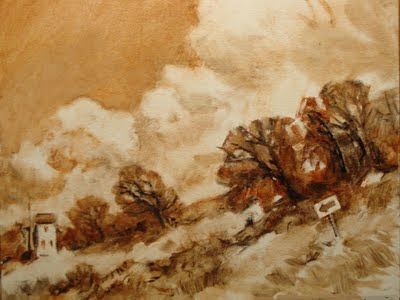 Rockport from Front Beach. Bearskin neck is the spit of land on the left. Notice the red granite in the foreground. Rockport was aquarying town in the 19th and early 20th century and this hard red granite was exported all over for building bridgges monuments and office buildings.
Rockport from Front Beach. Bearskin neck is the spit of land on the left. Notice the red granite in the foreground. Rockport was aquarying town in the 19th and early 20th century and this hard red granite was exported all over for building bridgges monuments and office buildings.There is another Encyclopedia of Dumb Design Ideas post ready for tomorrow or the next day. but it seems like I am on a theme here. I will talk a little about the art colony as it was in the early eighties. THis may read a little like a laundry list, and you may not know many of the names here. But it is useful that they get written down.I don't know that anyone has written anything about Rockport during this era. Rockport was past its heyday but there was still a a lot going on there.
Here are some of the artists who had galleries at the time.
- Paul Strisik ( National Academy)
- Tom Nicolas (National AScademy) -T.M. Nicholas
- David and Line Tutwieler and Charles Vickery
- John Caggianno (opened a year before me)
- Bruce Turner
- Lou Burnett and Martha Moore
- Dorothy Ramsey and Mike Stoffa
- Al Ruben
- Ferdinand Petrie
- Wayne Morell
- Joe Santoro (on Railroad ave) also National Academician.
- Shumacher (deceased but still showing seascapes)
- Charlie Stepule
- Nathalie Nordstrand
- Betty Lou Schlemm
- Mildred Jones (on a side street, later ran over her close friend Marian Williams Steele in the parking lot of ther Rockport National Bank, almost killing her.
- Allenbrook a portrait painter, I never knew him.
- Domenic Demari
- Don Mosher, Christine Mosher
- Stilson
- Dorothy Robbins
- Sven Orville Carlson
- John Terelak and Martin Ahearn
- Rudy Colao, Pam Fox and Fred MacNeil
- Peter Vincent
- Al Czerepak
- Helen Van Wyck home and teaching studio
- Charles Gordon Marston
- Jack Callahan was around but I think had given up his gallery.
Ellens Harborside restaurant was a good affordable place to have a seafood dinner and I often saw artists there. Alan Davidson and Lucien Geraci were always there together. In the summer Charles Vickery came to town and occasionally sat down at my easel and painted seascape demos for me. Joe Santoro used to come in and put his arm around me, very Italian. He was a watercolorist and a member of the Guild and a National Academician. Walker Hancock another Academician was still making sculpture in nearby Lanesville I was invited to draw the figure in his studio with a small group several times a few years later.
There were a lot of soms and daughters of artists from the previous generations still around. There were Elaine Hibbard, Aldro's daughter, John Manship who was Pauls Manships son. And The Beals, Ren, Bill and Telka. Ren was the grandson of Renolds Beal and the nephew of Gifford Beal. I believe he was related to Stow Wengenroth too. Richard Kuehne the son of Max Kuehne the American impressionist and gilder.
Harry Ballinger was still around and I met him on painting jury for the art association I think he was about a hundred. His seascape painting book is still a classic. Marshall Joyce still sent watercolors to the shows at the Association. There were also some good retired illustrators around at the time, like John Wentworth and some GI combat artists. My head is spinning, there were so many artists there at that time,Not all were great, but just the energy of so many people painting in such a small town was exciting . Painting was the industry of Rockport. Most or all of these names may mean nothing to you but they are who was around in Rockport at that time. Aldro Hibbard, Anthony Cirino and Lester Stevens, and Carl Peters were more or less recently deceased when I arrived.
There was also an army of retire commercial artists making art in their retirement and top flight amateurs trying to ramp themselves up to professional. Every summer also brought visiting artists from around the country, come to see what Rockport was like. I met a number of artists from around the nation while sitting in my shop.
I started going on painting trips to Vermont with some of the older guys, Tom Nicholas, John Terelak and Don Mosher I think this might have been a little later. I did paint landscapes a lot with Bruce Turner.
With a few exceptions everyone on the above list is dead. If in 1983 I had made a list of the established Rockport artists I could have listed thirty or more. Today, all but a handful are gone. I guess I should have thought about that coming, then, but I didn't. Many of them could tell stories of painting with Frank Dumnond or studying with Soyer or Brachman at the Art Students League before the second World War. A few knew Gruppe and Hibbard. A few old women had studied with William Merrit Chase. Genevieve Wilhelms, who I hardly knew, hung out with John Sloan and Edward Hopper, I think. Many could describe the art colony during the fifties when it was really full of artists and many of that great first generation were still alive. I should probably write down more of this stuff as it will be lost and forgotten soon.



























